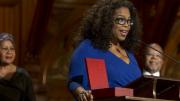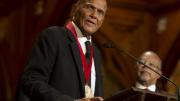Accepting the W.E.B Du Bois Medal for the late writer and activist Maya Angelou in Sanders Theatre Tuesday evening, Oprah Winfrey, LL.D. ’13, recalled what she said were some of the greatest times and memories of her life: sitting at Angelou’s table, eating biscuits.
“She spoke six different languages, and she was most fluent in the poetry of humanity,” Winfrey said. “I miss her deeply. There are times when something great like this happens, and I think to call Maya first, and then I realize I can’t. But her spirit abides with me, around me, through me, and with us.”
Joining Winfrey onstage to accept their own medals were architect David Adjaye, artist and activist Harry Belafonte, Congressman John L. Lewis, LL.D. '12, of Georgia, Oscar-winning filmmaker Steve McQueen, television producer Shonda Rhimes, and Miramax founder Harvey Weinstein. First presented in 2000, the Du Bois Medal is Harvard’s highest honor in the field of African and African-American studies; it recognizes outstanding contributions to African-American culture. This year, its recipients reflected a focus on the arts, apart from Lewis, who was unable to receive his medal last year because of the government shut-down.
After the Kuumba Singers performed a moving opening song, “Lift Every Voice and Sing,” Fletcher University Professor Henry Louis Gates Jr., director of the W.E.B. Du Bois Institute for African and African American studies, spoke about the importance of African-American art throughout history as a force for political equality. The ceremony also served as a formal introduction of the Ethelbert Cooper Gallery of African and African American Art at the Hutchins Center for African and African American Research, a crucial new addition to both Harvard Square and the Harvard community, Gates said. Designed by honorand Adjaye and slated to open this fall, the gallery will feature contemporary African and African-American art in its exhibitions and installations.
Lewis, who was introduced by Massachusetts governor Deval Patrick ’78, J.D. ’82, recalled growing up in rural Alabama and being upset by signs that said “‘White Men, Colored Men, White Women, Colored Women.’ My parents told me, whenever I asked a question, ‘That’s the way it is, don’t get in their way, don’t get in trouble.’ And I got in trouble,” the civil-rights activist recalled. “Good trouble. Necessary trouble.”
Belafonte, an Emmy, Grammy, and Tony Award winner known as the “King of the Calypso,” recalled how he joined the U.S. Navy at the age of 17 to combat fascism, and how after two years soldiers returned home from World War II with a great sense of victory. It was while sitting in the home of W.E.B Du Bois in Brooklyn, listening to poetry, that Belafonte said he saw what his life, and his path, could be. “[That sense of victory] permeated the planet, except for that one little space called black America, where all the benefits we struggled for were not generously imparted,” he said. “Having chosen to be in the arts, I met Paul Robeson when I was very young, and Robeson in turned led me to W.E.B Du Bois.”
Geyser University Professor William Julius Wilson introduced Steve McQueen, whose film 12 Years a Slave won the 2014 Academy Award for best picture—honoring “a body of work that allows us to look at and change our perspective,” Wilson said.
Graduate School of Design dean Mohsen Mostafavi introduced the next honorand, Adjaye, the Portman Design Critic in Architecture at the school, who has been the “master craftsman” behind major art centers and public buildings across the world. His National Museum for African American History and Culture on the National Mall in Washington, D.C., part of the Smithsonian Institution, is expected to open in 2016.
Du Bois professor of the social sciences Lawrence Bobo introduced screenwriter and producer Rhimes, who is known as the “Queen of Thursday night television” for her hit series Grey’s Anatomy and Scandal, and a new program this season, How to Get Away with Murder, starring Academy Award-nominee Viola Davis. And ART artistic director Diane Paulus introduced Weinstein, her partner for the company’s most recent production, Finding Neverland, which is now headed to Broadway.
President Faust took the stage to bestow the final medal of the evening—on Winfrey. “When I first started in television I was just happy to be on TV,” the honorand said. “But I soon learned this is a platform I can use, and not be used by it. I can use television to not just entertain people, but to inform them, to engage them—to bring little pieces of light into their lives.”










